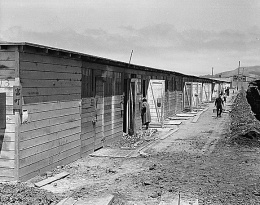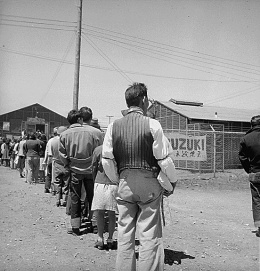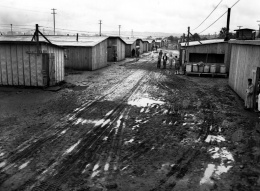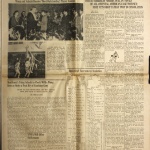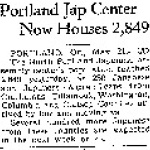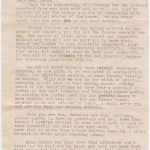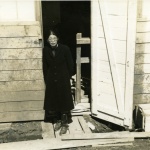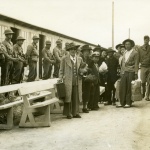Assembly centers
"Assembly centers" were makeshift concentration camps providing temporary housing for about 92,000 people of Japanese ancestry uprooted under Executive Order 9066 . Altogether fifteen [1] of these emergency camps were set up by the army pending the construction of more permanent inland concentration camps. Those incarcerated in "assembly centers" spent an average of about three months there before being transferred to a permanent concentration camp. The principal reason for the temporary "assembly centers," according to the army, was the need for immediate incarceration of Japanese Americans living on the West Coast.
Establishing the Assembly Centers
Executive Order 9066 authorized the removal for "any or all persons" from " military areas ." Public Proclamation No. 1 (March 2, 1942) predicted the eventual exclusion of all persons of Japanese ancestry from Military Area No 1, where 85 percent of all Japanese Americans in the continental United States lived. When only a few Nikkei left their homes voluntarily, the military decided on the forceful evacuation and incarceration.
The principal agencies involved in organizing the mass exodus were the Civil Affairs Division (CAD, a branch of the WDC), and the Wartime Civil Control Administration (WCCA, the operating agency of the CAD), created on March 10 and March 11, 1942, respectively. The WCCA was responsible for setting up, equipping and running the "assembly centers." Head of the WCCA's Assembly Center Branch was Rex L. Nicholson, formerly a Regional WPA supervisor. Nicholson left the WCCA in mid-July and was replaced by Emil Sandquist. [2] The WCCA enlisted the help of various civilian agencies, among them the U.S. Employment Service, the U.S. Public Health Service, the Farm Security Administration, and the Federal Reserve Bank. [3]
Site Selection and Construction
As the army was constructing inland concentration camps it also looked for facilities to temporarily incarcerate the West Coast Nikkei in the restricted zones. On March 16, 1942, Colonel Karl Bendetsen instructed two site-selection teams to locate facilities capable of housing 100,000 people. Within four days these teams reported back, listing seventeen potential sites. On March 20 the Army's Engineer Corps started the construction of fifteen temporary "assembly centers." The deadline for their completion was April 21, 1942. [4]
There were twelve "assembly centers" in California, and one each in Washington, Oregon, and Arizona. In addition to these fifteen detention camps there were two "reception centers"––Manzanar, California, and Colorado River, Arizona––that are sometimes classified as "assembly centers." Manzanar was initially operated by the army until the WRA took it over on June 1, 1942, while Colorado River was never under army control. Two "assembly centers" were partially readied for use but were never employed: Toppenish , in eastern Washington, and Cave Creek, Arizona. [5]
| "Assembly Center" | Maximum Population | Dates Occupied | Agency Operating Site Post-"Assembly Center" |
|---|---|---|---|
| Fresno , CA | 5,120 (Sept. 4) | May 6 - Oct. 30 | 4th Air Force Technical Training Command |
| Marysville , CA | 2,451 (June 2) | May 8 - June 29 | VII Army Corps |
| Mayer , AZ | 245 (May 25) | May 7 - June 2 | Forestry Service |
| Merced , CA | 4,508 (June 3) | May 6 - Sept. 15 | 4th Air Service Area Command |
| Pinedale , CA | 4,792 (June 29) | May 7 - July 23 | 4th Air Force |
| Pomona , CA | 5,434 (July 20) | May 7 - Aug. 24 | Ordnance Motor Transport |
| Portland , OR | 3,676 (June 6) | May 2 - Sept. 10 | Portland Port of Embarkation |
| Sacramento , CA | 4,739 (May 30) | May 6 - June 26 | Signal Corps |
| Puyallup , WA | 7,390 (July 25) | April 28 - Sept. 12 | 9th Service Command |
| Salinas , CA | 3,586 (June 23) | April 27 - July 4 | VII Army Corps |
| Santa Anita , CA | 18,719 (Aug. 23) | March 27 - Oct. 27 | Ordnance |
| Stockton , CA | 4,271 (May 21) | May 10 - Oct. 17 | 4th Air Service Area Command |
| Tanforan , CA | 7,816 (July 25) | April 28 - Oct. 13 | North. California Sector, WDC |
| Tulare , CA | 4,978 (Aug. 11) | April 20 - Sept. 4 | VII Army Corps |
| Turlock , CA | 3,661 (June 2) | April 30 - Aug. 12 | 9th Service Command |
Except in Portland, Pinedale, Sacramento, and Mayer, large fairground or racetracks were selected to minimize the need for building extra housing. At the racetracks, stables were cleaned out for use as living quarters. At the Portland Assembly Center over 3,800 evacuees were housed under one roof in a livestock pavilion subdivided into apartments.
In most centers additional barracks had to be built to provide housing, mess halls, and sanitation facilities. Construction followed specifications established for army cantonments, which made them "more ideally suited for troops than they were for the housing of families." [6] Barracks were grouped into blocks with separate communal bathrooms and mess halls.
Roundup
The transfer to the temporary detention centers was facilitated by so-called " Civilian Exclusion Orders " (CEOs). The WDC released 108 CEOs, uprooting 110,442 persons of Japanese ancestry. The first CEO was released on March 24, forcing the 55 Japanese-American families living on Bainbridge Island , near Seattle, to leave their homes within six days. The last CEO was issued on July 22, 1942, ordering 1,732 Japanese Americans in Tulare County to leave by August 11, 1942. Of the 110,442 persons expelled by CEOs, 18,026 were moved directly to the two "reception centers," while 92,193 were incarcerated in "assembly centers." The army evacuated first areas close to military installations and, wherever possible, moved the families to detention centers close to their homes.
Life in the "Assembly Centers"
Induction, Housing, Mess Halls
At arrival a cursory medical check was made and soldiers inspected the baggage was for contraband. Weapons, straight-edged razors, short-wave radios and liquor were confiscated. [7]
Though the army claimed the space allotted to a couple was 10 x 20 feet (larger families receiving accordingly larger allotments) it failed to meet its own standards. In Tulare, the average living space was little more than 2 x 4 feet per person. In Tanforan, half of the inmates were housed in horse stables with three to six people occupying a stall that had formerly accommodated one horse. [8]
Barracks for housing were uniform in size and appearance, each measuring 20 x 100 feet and comprised of either five apartments each intended for six persons, or ten smaller apartments meant for three persons each. Smaller families often had to share one unit. All barracks had plywood partitions about eight feet high, leaving an open space between each partitioned room.
Each "apartment" was equipped with army cots and a light bulb. Apart from cots the only things the WCCA issued were a cotton mattress or a straw tick and two blankets per person. Consequently, barracks were little more than places to sleep. All other activities took place in the various communal barracks. Communal feeding was provided in central mess halls. Newly constructed barracks usually seated 150 persons who ate in two, sometimes three shifts. Again, the situation could vary considerably from camp to camp: In Santa Anita there were three large mess halls, and meals were served in three shifts of 2,000 each. During the induction weeks, the WCCA served A Rations and B Rations in most camps. Later the diet consisted of canned food including lima beans, Vienna sausages, and chili con carne. After the first two weeks food improved considerably, though inmates agreed that it left much to be desired. The average daily ration cost per capita for all "assembly centers" were $0.38. [9]
Sanitary Facilities, Medical Treatment
Latrines, washrooms, and laundries were located in separate buildings and in short supply. Latrines often lacked partitions, though after vehement protests the WCCA later installed them. Washrooms contained between eight and fifteen showers, partitioned, but without doors or curtains. The shower-inmate ration was usually around 1 to 23. Washrooms as well as laundries regularly ran out of hot water and often required a long wait in line. On the whole, the sanitary situation was an embarrassing hardship, especially for the elderly people, pregnant women, and the sick. [10]
Medical service was free but even for a prison the service was inadequate. Though most diseases were not critical, the inability to treat them properly added to the discomfort. Almost all evacuees had a cold most of the time, and due to malnutrition, skin problems were widespread, as were digestive problems. Most temporary detention centers had at least one major outbreaks of diarrhea. More serious illnesses were treated at nearby hospitals. During the first two months the Public Health Service vaccinated most inmates against typhoid and smallpox, and diphtheria.
Work and Employment
The WCCA decided to employ evacuees "to the fullest extent practicable" to lower the costs of running the camps. About one third of the inmates between 18 and 65 were employed. In Tulare (pop. 4,900) a total of 1,200 inmates were employed, 500 of them in the mess halls and kitchens and 200 in the works and maintenance division. [11]
Persons assigned to jobs worked on a 44-hour per week basis and were classified as unskilled, skilled or professional at monthly wage rates of $8, $12, and $16 respectively. No inmate was required to work, but once he accepted a job, he was expected to carry it out except in case of illness. To quit, a 48-hour notice of intent was required. The average income of the civilian WCCA staff was $200 per month.
About 200 evacuees from the fifteen "assembly centers" worked in the sugar beet fields of Idaho, Montana and Oregon. It remained the only case of private employment. California Governor Culbert Olson's plan to keep Japanese Americans in the temporary detention centers through fall to use them as fruit pickers was rejected by the War Department. In Santa Anita inmates manufactured camouflage nets for the army on a volunteer basis. [12]
Starting in June, inmates were given monthly allowances in coupons to purchase basic necessities such as clothing. The monthly coupon allowance was $1.00 for evacuees under 16, $2.50 for evacuees over 16, $4.50 for married couples, and a maximum of $7.50 for families. [13]
Security
Although the military downplayed the prison-like nature of the "assembly centers," the features of confinement were impossible to ignore. There were fences and watchtowers, strict visiting regulations, and a 10 p.m. to 6 a.m. curfew, though on August 15, 1942, the WCCA declared that the detention centers could decide individually whether a curfew was necessary.
On June 17, the WCCA ruled that twice a day a roll call was to be held, one in the morning and once in the evening. A Nisei wrote to a friend outside: "[I]t's asinine, but it's army's orders. Imagine making such a count when we are enclosed within barbed wire fence and guards walking every 50 feet and sentries in watch towers every 100 yards with guns ready to kill." [14]
For every two hundred inmates, the army employed one civilian policemen who were authorized to enter all buildings and evacuee quarters without warrant. [15] Additionally, in most camps a sizeable number of Japanese Americans served as auxiliary policemen. Besides maintaining order within the compound, the Internal Police checked all visitors and incoming parcels to ensure that no contraband entered the camp. Mail, unlike parcels, was exempted from censorship. Bendetsen tried to get a blanket warrant to open and censor domestic mail but the War Department denied its approval. [16] However, even without authorization the army opened some letters, mostly inter-camp mail.
Education, Recreation, Religion, Camp Newspapers
Although the WCCA provided no formal system of education and recreation, comprehensive programs sprung up in most camps due to the inmates' initiative and outside support from private organizations, schools, and churches. Complementing nursery school, elementary school, and high school classes, a program for adults was usually set up, too, including Americanization classes in English, civics, and history, as well as flower arranging ( ikebana ) and paper folding ( origami ) classes. [17]
Recreation was organized cooperatively between the WCCA and the Japanese Americans. Barracks and open spaces were remodeled into makeshift gyms, basketball courts, and baseball diamonds. In most camps, inmates organized baseball and basketball leagues. Other sports to be found were football, table tennis, boxing, or judo, as well as go and shogi . Movies were shown regularly at many centers, and some centers even had libraries. [18]
The WCCA allowed the inmates to hold religious services within the camps and to request necessary assistance from outside leaders. Most inmates were either Buddhist or Protestant. Cooperation between the denominations was widespread, as was competition. In Tanforan, for example, the mother's day program was initiated by a Methodist minister, but during the program several Buddhist and Catholic priests spoke. Some camp directors exempted church service from the ban on Japanese language.
Army regulations required that all meetings within the camp be conducted in the English language except for adult classes. The use of spoken Japanese language was to be "held to an absolute minimum." Any news publication prepared or issued in the Japanese language was forbidden. Japanese prints of any kind with the exception of approved Japanese religious books and English-Japanese dictionaries were considered contraband and confiscated. [19]
Recognizing the need to disseminate information within the camps the army allowed for the publication of camp newspapers. All "assembly centers," except Mayer, had a mimeographed newspaper. The WCCA provided a Press Relation Representative who censored information that he deemed inappropriate, especially the topics relating to the incarceration. Camp newspapers were published in English exclusively. The papers contained official announcements such as visiting policies, roll call regulations, clarifications on scrip book allowances, as well as disclaimers of persistent rumors, schedules of church service and recreational activities, opening hours of the hospital and the post office. [20]
Administration and Self-government
The temporary detention centers were largely staffed by civilian personnel "borrowed" from the WPA. While Caucasians occupied all supervising positions Japanese Americans did most of the actual work. [21] Soon after induction informally elected house managers played an important role in organizing everyday needs and mediating between the inmates and their keepers. Eventually, Japanese Americans attempted to establish a more formal system of self-government. Although the WCCA never authorized self-government in the "assembly centers," its initial silence on the issue led to various democratic experiments. Almost all camps elected "evacuee councils." They were helpful in organizing day-to-day business and sometimes even influenced administrative policies.
The WCCA initially tolerated the inmate councils because they made running the camps easier, and because they served the propaganda effort. However, as some "assembly center" councils got increasingly involved in administrative tasks the WCCA abolished them. [22]
Departures, Closing
Beginning May 26, 1942, Japanese Americans were transferred from the fifteen temporary detention centers to the ten inland concentration camps. The transfers were completed by October 30, 1942. Following the deportation of inmates to concentration camps, the "assembly center" sites were used by various army agencies, such as ordnance, signal corps, quartermaster, and transportation corps. [23]
About 600 inmates not deported to the inland concentration camps and allowed to leave the detention centers. From March 21 to October 30, 1942, the WCCA released 206 persons from the "mixed-marriage" families––mixed-blood children and Issei women with non-Japanese husbands. In the same time, about 360 students acquired permission to attend colleges and universities outside the West Coast, with close to 3,000 students remaining in captivity. In addition, 54 Issei left in June 1942 to be repatriated to Japan. Many more applied for release but WCCA regulations were very strict and there was no "right to leave" even if one qualified. [24]
For More Information
Burton, Jeffery F., Mary M. Farrell, Florence B. Lord, and Richard W. Lord. Confinement and Ethnicity: An Overview of World War II Japanese American Relocation Sites . Western Archeological and Conservation Center, National Park Service, 1999, 2000. Accessible online.
Commission of Wartime Internment and Relocation of Civilians. Personal Justice Denied: Report of the Commission on Wartime Relocation and Internment of Civilians . Seattle: University of Washington Press, 1997.
Daniels, Roger. Concentration Camps: North America. Japanese in the United States and Canada During World War II . Malabar, FL: Krieger Publishing, 1989. (Original title "Concentration Camps, USA," 1971)
Fiset, Louis. Camp Harmony: Seattle's Japanese Americans and the Puyallup Assembly Center . Urbana: University of Illinois Press, 2009.
Inada, Lawson Fusao (ed.). Only What We Could Carry. The Japanese American Internment Experience . Berkeley: Heyday Books, 2000.
Kashima, Tetsuden. Judgment Without Trial: Japanese American Internment during World War II . Seattle: University of Washington Press, 2004.
Modell, John (ed.). The Kikuchi Diary. Chronicle from an American Concentration Camp: The Tanforan Journals of Charles Kikuchi . Urbana: University of Illinois Press, 1973.
Okubo, Mine. Citizen 13660 . New York: Columbia University Press, 1946.
Robinson, Greg. A Tragedy of Democracy: Japanese Confinement in North America New York: Columbia University Press, 2009.
Uchida, Yoshiko. Desert Exile. The Uprooting of a Japanese American Family . Seattle: University of Washington Press, 1982.
U.S. Army. Final Report: Japanese Evacuation from the West Coast, 1942 . Washington, D.C.: GPO, 1943.
Footnotes
- ↑ Sometimes Manzanar is included in the count, raising the number to sixteen. The number is seventeen if Colorado River (Poston) is included, although Poston never was under army control and thus technically not an "assembly center."
- ↑ U.S. Army. Final Report , 47.
- ↑ U.S. Army. Final Report , 237-240, 522-525.
- ↑ U.S. Army. Final Report , 44-48.
- ↑ U.S. Army. Final Report , 158-159; CWRIC. Personal Justice Denied , 138.
- ↑ U.S. Army. Final Report , 184.
- ↑ CWRIC. Personal Justice Denied , 136-137.
- ↑ Uchida. Desert Exile , 70.
- ↑ U.S. Army. Final Report , 184; CWRIC. Personal Justice Denied , 141-142.
- ↑ Uchida. Desert Exile , 76; Okubo. Citizen 13660 , 69, 77.
- ↑ U.S. Army. Final Report , 422.
- ↑ Memorandum , Secretary of War Stimson to President Roosevelt, July 7, 1942; U.S. Army. Final Report , 205.
- ↑ U.S. Army. Final Report , 224.
- ↑ Letter , Fred Hoshiyama to Lincoln Kanai, June 16, 1942, JERS 18:135.
- ↑ Memorandum: Functions of the Military Police Units at Centers for Japanese Evacuees , WCCA, JERS 12:132. See also U.S. Army. Final Report , 215-217.
- ↑ Teletype, John L. DeWitt to Army Chief of Staff, May 26, 1942, qtd. in Fiset, Camp Harmony, 134. See also Censorship of Mails in Assembly Centers, Military High Command, Public Branch, May 28, 1942, and Memorandum of Colonel King's Telephone Coversation with Mr. Jaretzki, Military High Command, Public Branch, May 28, 1942 1942, NA II, RG 499, WDC, Unclassified Correspondence, Box 2.
- ↑ U.S. Army. Final Report , 207-209; CWRIC. Personal Justice Denied , 144-145.
- ↑ U.S. Army. Final Report , 209-211; CWRIC. Personal Justice Denied , 145.
- ↑ WCCA Assembly Center Regulations , JERS 12:090-328; Modell (ed.). The Kikuchi Diary , 139; Minutes of the Fifth Tanforan Town Hall Meeting , June 24, 1942, JERS 16:013.
- ↑ U.S. Army. Final Report , 213.
- ↑ U.S. Army. Final Report , 223-224.
- ↑ WCCA Operation Manual, Supplement No. 8 , Col. Karl R. Bendetsen, August 1, 1942, JERS 12:303-306.
- ↑ U.S. Army. Final Report , 183.
- ↑ U.S. Army. Final Report , 319, 374; Memorandum, Maj. Herman P. Goebel (FA) to W. H. Cheney (WCCA), July 12, 1942, NA II, RG 499, WDC, Microfilm Copy of the Assembly Center Records, Box 13, Reel 149.
Last updated Dec. 11, 2023, 8:01 p.m..

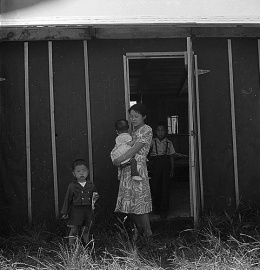 Media
Media
